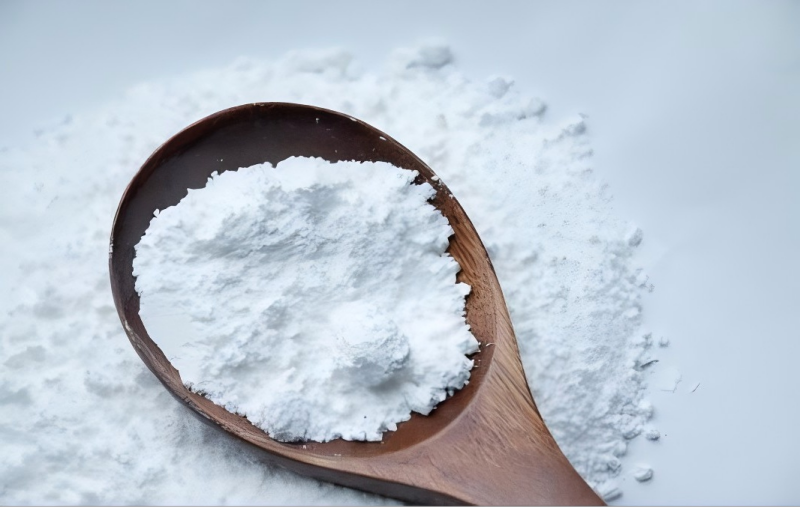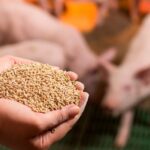Many fungi can make fumaric acid. But fungi from the Rhizopus group are the best at it. Scientists often use Rhizopus nigricans, Rhizopus arrhizus, and Rhizopus oryzae. They use them in nature and in factories. Rhizopus species are the top makers of fumaric acid. Aspergillus and other fungi do not make as much.

Fungi Producing Fumaric Acid
Rhizopus Species
Scientists say Rhizopus fungi are the best at making fumaric acid. Rhizopus oryzae, Rhizopus arrhizus, and Rhizopus nigricans are used a lot in labs and factories. Rhizopus delemar helps too, and some experts think it is the same as Rhizopus oryzae. These fungi grow well in labs and factories. They change glucose into fumaric acid very well.
Studies show Rhizopus delemar is a main producer. Scientists checked how much fumaric acid it makes in different tests. They found it works really well. The table below shows how much fumaric acid each Rhizopus fungus can make:
| Species | Fumaric Acid Yield (g/g glucose) | Fumaric Acid Concentration (g/L) | Productivity (g/L/day) | Notes |
|---|---|---|---|---|
| Rhizopus oryzae | Up to 0.93 | Up to 32.1 | 7.7 (approx.) | Highest yield reported; optimized conditions; includes R. delemar (synonym) |
| Rhizopus delemar | Considered synonymous with R. oryzae | N/A | N/A | Alternative name for R. oryzae |
| Rhizopus arrhizus | 0.6 to 0.75 (60-75%) | N/A | 6 to 8.4 | From fermentation on potato flour; lower yield and productivity than R. oryzae |
| Rhizopus nigricans | N/A | N/A | N/A | No quantitative data reported |
| Rhizopus formosa | N/A | N/A | N/A | No quantitative data reported |
Rhizopus oryzae makes the most fumaric acid. It reaches the highest amount and concentration. Rhizopus arrhizus also does well, but not as much as Rhizopus oryzae. Rhizopus nigricans and Rhizopus formosa are named in studies, but scientists did not give exact numbers for them.
Aspergillus Strains
Aspergillus fungi can make fumaric acid, but not as much as Rhizopus. Aspergillus niger is the one scientists study most. They measured how much it makes, but it is less than Rhizopus. The table below shows results for Aspergillus niger:
| Filamentous Fungus | Strain | Fumaric Acid Yield (g.L−1) | Notes |
|---|---|---|---|
| Aspergillus niger | BRFM422 | 0.7 ± 0.2 | Conversion yield 2.3% |
| Aspergillus niger | BRFM438 | <0.05 (below quantification limit) | Very low production |
Scientists found Aspergillus niger BRFM422 made about 0.7 g/L of fumaric acid. The BRFM438 strain made even less, too little to measure. Aspergillus oryzae is sometimes mentioned, but it mostly makes malic acid instead.
Other Filamentous Fungi
Other fungi like Aureobasidium and Penicillium do not make much fumaric acid. Some yeasts and other molds can make acids, but they make very little fumaric acid. Most studies say Rhizopus and Aspergillus are the main fungi for fumaric acid. Rhizopus oryzae is important for factories and is safe for food.
Fumaric Acid Production Process
Rhizopus Fermentation Methods for Fumaric Acid Production
Rhizopus fungi use different ways to make fumaric acid. Scientists often pick batch fermentation with Rhizopus oryzae. They give glucose as food and keep the pH close to 3.6. This way, they can get about 20 grams per liter of fumaric acid. Another way is continuous fermentation with immobilized cells. Here, Rhizopus oryzae cells stick to carriers and the pH stays near 4. This method can make up to 0.93 grams of fumaric acid for each gram of glucose. Rhizopus arrhizus grows on loofah fiber in stirred-tank reactors. The loofah helps the fungus get air and food. This leads to good fumaric acid production.
| Fermentation Method | Organism | Key Conditions/Notes | Reported Efficiency/Yield |
|---|---|---|---|
| Batch fermentation | Rhizopus oryzae | Nitrogen-limited, glucose as carbon source, pH 3.6 | ~20 g/L fumaric acid concentration |
| Continuous fermentation with immobilized cells | Rhizopus oryzae | Immobilized cells, optimized pH ~4 | Yield up to 0.93 g fumaric acid/g glucose |
| Immobilized fermentation on loofah fiber | Rhizopus arrhizus RH 7-13-9# | Loofah fiber (natural carrier) | Stirred-tank reactor |
Aspergillus-Based Techniques for Fumaric Acid Production
Aspergillus fungi use solid-state fermentation and submerged fermentation to make fumaric acid. In solid-state fermentation, scientists grow Aspergillus terreus and Aspergillus oryzae on wheat bran or corn cobs. They watch moisture and pH to help the fungus grow and make more acid. Aspergillus terreus on wheat bran can make 0.8 milligrams of fumaric acid for each gram of biomass. Aspergillus oryzae makes a little less. Submerged fermentation uses sugars that dissolve in water. It usually gives more fumaric acid than solid-state fermentation, but scientists do not always share exact numbers.
| Fermentation Technique | Aspergillus Species | Substrate | Typical Fumaric Acid Yield (mg/g biomass) | Notes |
|---|---|---|---|---|
| Solid-State Fermentation (SSF) | Aspergillus terreus | Wheat bran | 0.8 | Optimized conditions including pH, moisture, enzymatic hydrolysis; regular yield increase |
| Solid-State Fermentation (SSF) | Aspergillus oryzae | Wheat bran | 0.6 | Growth plateau after 120 h; enzyme production supports saccharification |
| Solid-State Fermentation (SSF) | Aspergillus terreus | Corn cobs | 0.14 | Maximum yield at 48 h, then decreases |
| Solid-State Fermentation (SSF) | Aspergillus oryzae | Corn cobs | 0.12 | Similar profile to A. terreus on corn cobs |
| Submerged Fermentation (SmF) | Various Aspergillus | Soluble sugars | Higher than SSF yields | Mentioned as having higher productivity but no specific yield data provided |
Environmental and Biological Factors Influencing Fumaric Acid Yield in Fungal Fermentation
Many things change how much fumaric acid fungi can make. Small fungal pellets help Rhizopus get enough air and food. Glucose is the best carbon source, but xylo-oligosaccharides in solid-state fermentation can help make more acid. Ammonium salts and yeast extract help the fungus grow. Higher pH and more oxygen make more fumaric acid. Solid-state fermentation gives better results than doing hydrolysis and fermentation separately. Immobilizing the fungus helps control its shape and lets it keep making acid. Taking out fumaric acid during fermentation stops buildup and keeps yields high. More solids in solid-state fermentation also raise the final amount.
Tip: Keeping the pH between 4 and 5 and dissolved oxygen above 60% helps fungi make more fumaric acid and less ethanol.
Industrial Fumaric Acid Production
Advantages of Using Specific Fungi for Industrial-Scale Fumaric Acid Production
Factories often pick Rhizopus oryzae and Rhizopus arrhizus to make fumaric acid. These fungi give many benefits:
- They make a lot of fumaric acid by themselves.
- The fermentation uses cheap materials, so companies spend less.
- This process mostly makes fumaric acid, with few extra things. That makes cleaning up easier.
- Rhizopus oryzae needs only simple food, so it is cheap to grow.
- Rhizopus arrhizus can make even more product, but it needs better food.
- The method is good for the environment and uses less energy than making fumaric acid with chemicals.
Factories in China and other places use Rhizopus because it works well in many types of factories.
Selection Criteria for Fungal Strains Used in Industrial Fumaric Acid Production
Companies want fungi with special traits for making fumaric acid. The most important things are:
- Making lots of fumaric acid.
- Simple ways inside the fungus that help make fumaric acid.
- Growing well when the pH is low and there is lots of oxygen.
- Easy to control the fungus’s shape and size while it grows.
- Cheap food and materials for the fungus.
- Not many extra things made, so cleaning is easier.
The table below shows the highest amounts different fungi can make:
| Fungal Strain | Reported Maximum Fumaric Acid Yield | Notes |
|---|---|---|
| Rhizopus oryzae and Rhizopus arrhizus | Not explicitly quantified | Known natural producers with high fumaric acid accumulation; no specific yield values provided in the source. |
| Engineered Saccharomyces cerevisiae | Up to 5.64 g/L | Achieved under optimized conditions (carbon/nitrogen ratio, biotin addition, overexpression of pyruvate carboxylase). |
| Engineered Saccharomyces cerevisiae with RoFUM1 gene | Decreased fumaric acid titer | Introduction of RoFUM1 gene from Rhizopus oryzae reduced fumaric acid production, indicating pathway engineering challenges. |
Rhizopus oryzae and Rhizopus arrhizus are still the best for making fumaric acid in factories. They give high amounts, cost less, and work well every time.
Fumaric Acid Production Table
Summary Table of Fungi Species and Their Fumaric Acid Production Yields
Scientists test many fungi to see how much acid they make. Some fungi do a better job than others. The table below lists the main fungi and how much acid they usually make. This helps you compare them fast.
| Fungal Species | Typical Yield (g/L or mg/g biomass) | Method Used | Notes |
|---|---|---|---|
| Rhizopus oryzae | Up to 32.1 g/L | Batch fermentation | Highest yield; often used in industry |
| Rhizopus arrhizus | 6–8.4 g/L | Immobilized fermentation | Good yield; needs special carriers |
| Rhizopus delemar | Similar to R. oryzae | Batch fermentation | Sometimes considered same as R. oryzae |
| Aspergillus niger | 0.7 g/L | Submerged fermentation | Lower yield than Rhizopus species |
| Aspergillus terreus | 0.8 mg/g biomass | Solid-state fermentation | Uses wheat bran; yield increases with time |
| Aspergillus oryzae | 0.6 mg/g biomass | Solid-state fermentation | Lower yield; growth plateaus after 120 hours |
| Aureobasidium spp. | Not reported | Various | Rarely used; low production |
| Penicillium spp. | Not reported | Various | Rarely used; low production |
| Engineered yeast | Up to 5.64 g/L | Genetic modification | Needs special lab conditions |
- Scientists look at these numbers to pick the best fungus for factories.
- Rhizopus oryzae makes the most acid and is easy to use.
Tip: Always check the yield and method before choosing a fungus. Some fungi need special tools or food to work their best.
The table helps you see which fungi work best. Rhizopus fungi make a lot of acid and are easy to grow. Aspergillus can make acid too, but not as much. Other fungi and special yeasts look good, but they do not beat the top ones yet.
Rhizopus species are the most important fungi for making acid in factories. They can use things like glucose and farm waste as food. These fungi work in both easy and hard fermentation systems. Scientists try to get more acid by changing how the fungus grows. They also use biofilm reactors and try new carriers to help.
FAQ
What is fumaric acid used for?
Fumaric acid is put in food, animal feed, and plastics. Factories use it to make drinks and candy taste sour. It also helps make resins and green products.
Why do factories prefer Rhizopus oryzae for fumaric acid?
Rhizopus oryzae makes a lot of acid and grows on cheap food. It works in many ways to ferment. Companies pick it because it gives more acid than other fungi.
Can Aspergillus fungi replace Rhizopus for fumaric acid production?
Aspergillus fungi can make fumaric acid, but they make less than Rhizopus. Factories do not use Aspergillus much for big production.
How do scientists increase fumaric acid yield in fungi?
Scientists change the food, pH, and oxygen. They use special carriers or gene editing. These steps help fungi make more fumaric acid and cut down waste.




